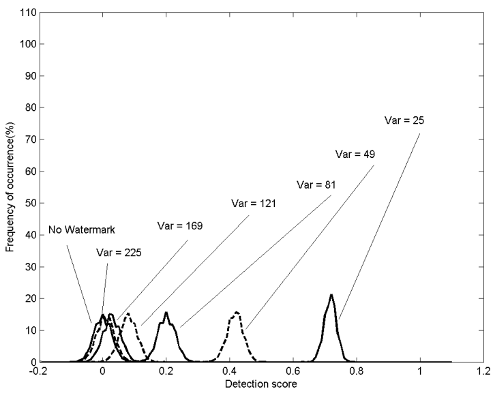Novel blind multiple watermarking technique for images
TLDR
Experimental results show that embedded watermarks using the proposed techniques can give good image quality and are robust in varying degree to JPEG compression, low-pass filtering, noise contamination, and print-and-scan.Abstract:
Three novel blind watermarking techniques are proposed to embed watermarks into digital images for different purposes. The watermarks are designed to be decoded or detected without the original images. The first one, called single watermark embedding (SWE), is used to embed a watermark bit sequence into digital images using two secret keys. The second technique, called multiple watermark embedding (MWE), extends SWE to embed multiple watermarks simultaneously in the same watermark space while minimizing the watermark (distortion) energy. The third technique, called iterative watermark embedding (IWE), embeds watermarks into JPEG-compressed images. The iterative approach of IWE can prevent the potential removal of a watermark in the JPEG recompression process. Experimental results show that embedded watermarks using the proposed techniques can give good image quality and are robust in varying degree to JPEG compression, low-pass filtering, noise contamination, and print-and-scan.read more
Figures

Fig. 30. (Left) MWE-watermarked image under LPF attack.PSNR = 31:82 dB. (Middle) Decoded watermark. (Right) Random watermark detection results. 
Fig. 26. Detection error of MWE under LPF attack. 
Fig. 6. (a) Original logo “UST”. (b)-(f) Original logo “Alphabet”. 
Fig. 23. Distribution ofS of MWE (IA-R, Q = 5) under JPEG attack. 
Fig. 28. Detection error of MWE under noise attack. 
Fig. 27. Distribution ofS of MWE under noise attack.
Citations
More filters
Journal ArticleDOI
Fractional Fourier transform as a signal processing tool: An overview of recent developments
TL;DR: This paper is geared toward signal processing practitioners by emphasizing the practical digital realizations and applications of the FRFT, which is closely related to other mathematical transforms, such as time-frequency and linear canonical transforms.
Journal ArticleDOI
An Oblivious Watermarking for 3-D Polygonal Meshes Using Distribution of Vertex Norms
TL;DR: Two oblivious watermarking methods for 3-D polygonal mesh models, which modify the distribution of vertex norms according to the watermark bit to be embedded, are proposed, which are remarkably robust against distortionless attacks.
Proceedings ArticleDOI
A robust multiple watermarking scheme in the discrete wavelet transform domain
Peining Tao,Ahmet M. Eskicioglu +1 more
TL;DR: The experiments indicate that first level decomposition appear advantageous for two reasons: the area for watermark embedding is maximized, and the extracted watermarks are more textured with better visual quality.
Journal ArticleDOI
A robust watermarking scheme using self-reference image
TL;DR: The experimental results show that the proposed scheme provides not only good image quality, but is also robust against various attacks, such as JPEG lossy compression, filtering and noise addition.
Journal ArticleDOI
A Video Watermarking Technique Based on Pseudo-3-D DCT and Quantization Index Modulation
TL;DR: An effective video watermarking method based on a pseudo-3-D discrete cosine transform (DCT) and quantization index modulation (QIM) against several attacks is proposed that can survive filtering, compressions, luminance change, and noise attacks with a good invisibility and robustness.
References
More filters
Proceedings ArticleDOI
Digital watermarking using inter-block correlation: extension to JPEG coded domain
Y. Choi,Kiyoharu Aizawa +1 more
TL;DR: A method which can embed/extract watermark with high speed by utilizing this watermarking method using inter-block correlation of DCT coefficients for JPEG file format is proposed.
Proceedings ArticleDOI
Image watermarking using spread spectrum technique in log-2-spatio domain
TL;DR: Low intensity and mid-band regions are selected to embed the information in log-2-spatio domain in order to guarantee an invisible watermark as well as the robustness to JPEG compression.
Proceedings ArticleDOI
Embedding watermarks into both DC and AC components of DCT
Yu-Jin Zhang,Ting Chen,Juan Li +2 more
TL;DR: A watermarking scheme taking advantage of both AC and DC coefficients of DCT, to increase the robustness of watermarks in resisting different attacks caused by processing or degradation is proposed.